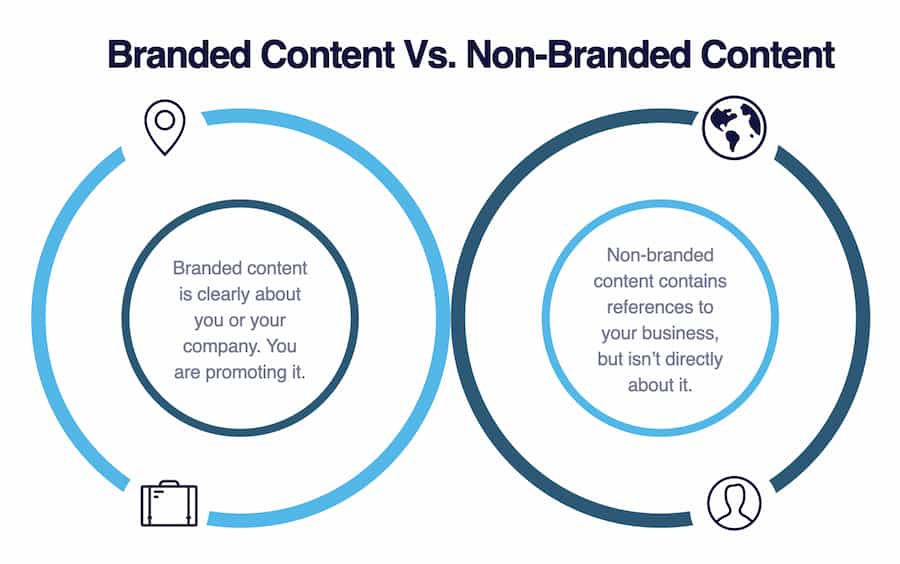Branded vs Non-Branded Content: What is the Difference?
- Branded content is clearly about your brand
- Non-branded content supports branded content
- Non-branded content is often about your industry or other supporting information about your brand, but indirectly
- Both kinds of content work together to create a positive online reputation
Differences: branded vs. non
Branded
Branded online content refers to digital content created and published by a company or brand (or a representative of the brand) to promote the brand’s products or services.
Branded content is often explicitly connected to a brand or product through branding elements or the content’s subject matter, which may be related to the brand’s core values or products. When used in online reputation management, branded content might include the brand name in the headline or lead paragraph or be substantially about the brand.
Non-branded
Non-branded content, on the other hand, is content that is not created with the primary goal of promoting a particular brand or product. If a brand is mentioned, it is often in a secondary or tertiary manner. This type of content may be informational, educational, or entertaining, and individuals, social media creators, media companies, or other entities may create it.
Non-branded content may be used to build brand awareness and engagement indirectly, but the content itself is not directly linked to a specific brand or product. Non-branded content is considered “support” content and is often used to drive clicks toward more brand-related content. Non-branded content tends to rank much further back in search results than branded content does.

What’s branded content?
Branded content is clearly about the brand. It appears to either represent the brand or portray it (or the product) as the subject of the content. It has your brand “written all over it,” even if you didn’t create the content. Your company, brand or a representative may be the author, or someone else is clearly creating content about your brand, but it’s clear who the content is about and usually who commissioned it.
It might be an outright commercial or demonstration of a service or product or an ad that shows the how, what, or why of your brand.
From an SEO perspective, branded content typically features the primary search phrase of the brand in the page title <title> and header <H1> tag, plus relevant secondary phrases sprinkled throughout.
Examples of branded content include:
- Full articles
- Blog posts
- Reviews
- Videos
- Podcasts
- Lists
- Infographics
- Tweets
- Facebook updates
Branded content is obviously about the brand
With branded content, there’s no attempt to hide the source or objective of the content. In fact, if readers don’t understand that it’s about you after making it through the first sentence or two, the content may not be doing its intended job.
Big-name companies increasingly view branded content as an integral marketing campaign component. Companies like Miller Coors are blurring the line between traditional marketing and reputation marketing with coordinated (and spendy) branded content campaigns.

Branded content is also designed to engage social sharing about the brand. Expanding on the exponential growth of his product, actor/businessman Dwayne Johnson and his tequila brand Teremana have used branded content to promote his liquor. While obviously creating content that promotes Teremana, he and his company have crafted fun blog and social media posts and urged his followers to share and add to the content. This approach effectively started a tidal wave of shared branded content while straightforwardly promoting his business.
Branded content is designed to achieve prominent search rankings when someone is searching for the brand. Ideally, branded content done well should rank on the first search results page for a given keyword. Though you shouldn’t count on a piece of content achieving a particular rank, the prominence of your target keyword and variations of it encourages higher visibility.
Miller Coors, Johnson, and others have shown that carefully crafted branded campaigns can work and get traction in social media and SEO.
As more companies discover the virtues of paying to place high-quality, unmistakably advertorial content (often long-form writing) on high-visibility web pages, and as concerns about “share-ability” make gains on the formerly all-important drive for optimal search placement, we’ll likely see a lot more of it.
Branded content engages brand queries
Sometimes it’s tough to create first-rate prose while upholding SEO best practices, but all online content needs to thread that needle. While search placement remains a core focus of any branding campaign, savvy web reputation management services also prize content that’s engaging enough to attract social shares for the brand. Properly branded content is designed to positively engage social sharing about the brand.
If we look at Teremana Tequila as an example again, we can see how the company has effectively used its brand prominently in its content. Teremana has published blog entries of tequila cocktail recipes that readers can create using their product. The SEO involved allows the content to be picked up for multiple keywords and it rises to the top of searches for cocktail recipes and tequila, as well as specific queries for Teremana, dominating the search results.

What is non-branded content?
Non-branded content is much more subtle than branded content.
While non-branded content might contain references to you, your company, or what you/it does, they’re typically more oblique and aren’t the focus of the piece. In practice, this means no brand-specific (your name, company name, etc.) mentions in the title or header and only sparing use throughout—if at all. If brand-specific mentions are used, the piece typically isn’t structured to rank for them in search. Non-branded content is not about the brand but still supports the industry or other areas of interest relative to the brand. The brand might be mentioned, but it is not the primary or even secondary focus of the content.
Put another way, non-branded content is intended to support branded content as part of the branded information matrix.
Non-branded content is generally distributed more widely than branded content. Since it doesn’t directly concern you and your company, non-branded content usually finds a wider audience—or is at least better suited to find that audience in terms of page views and shares—than branded material.
For example, a piece of branded content, “Company XYZ Is at the Forefront of ABC Industry,” could talk about how you’re the leading innovator in your industry. Your next piece of non-branded content, “5 Trends Driving ABC Industry,” could then address in general terms the interesting trends that affect your industry. Since the non-branded piece appeals to anyone interested in your industry, it’s likely to gain wider traction and shares. Often because it doesn’t feel like a piece is directly promoting a brand, audiences are more open to reading and sharing the content.

An example of successful non-branded content is the Adobe Personality Test. It invites visitors to take the quiz to learn more about their creative personalities and how they approach creativity. Taken by millions of users, it’s not an outright push to purchase Adobe products, instead allowing users to discover themselves and their personal creative type.
While it doesn’t directly advertise Adobe, its products, or services, it does get quiz participants into a mindset to think about their creativity, share the content, and be more likely to use Adobe. This not only supports the company’s branded content but also helps create a positive reputation for Adobe through a fun, insightful activity, and often users share their results, garnering more clicks and brand recognition without straightforward promotion.
Don’t overlook the positive and suggestive power of non-branded content. Always remember, it acts as a supporting player to branded content.
With an online publishing platform like social media, a blog, or a video channel, anyone can quickly and easily create and distribute positive content to enhance an online image and boost competitive advantage. Take a look at your industry. or the interests of your current and potential customers or clients. Just remember to always be authentic in your content creation.
But here’s the rub: Today’s online world is so saturated with content that it’s imperative that you create the right content and distribute it the correct way.
Helpful Resource: The Anatomy of a Search Result Page and How to Rank
Non-branded content is designed to support your reputation management campaign – not be its focus
This can seem counterintuitive since non-branded content is often shared or viewed more widely than individual pieces of branded content. But it’s true.
Think of your non-branded content as a cast of character actors supporting your branded content, the star of your reputation management show. Non-branded content published on high-authority websites—your own domains, well-trafficked blogs, and other web properties—is great for building links to your branded material.
If it’s done well, it should attract inbound links of its own from high-authority domains, boosting its attractiveness to search engines and creating brand authority around your web presence.
How are branded and non-branded content used?
Web reputation management services typically involve both branded and non-branded content. Both types of content incorporate key search terms that leverage latent semantic analysis (LSA) and are designed to show up in your Search Engine Results Pages (SERP’s).
Branded content will usually show up higher for brand-related search terms, often on the first pages. Non-branded content doesn’t perform as well in branded searches, but this type of content supports the branded content through links and shares on social media.
Both are usually positive in nature, working in unison to grow a better and positive online reputation. However, both require freshness updates to maintain high visibility in your SERPs. The important step is to continually generate new content, whether it be branded or non-branded.
Summary
- Non-branded content supports branded content
- Branded content is obviously about your brand
- Non-branded content is about your industry or other supporting information about your brand
- Both kinds of content work together
About the author
Kent Campbell is the chief strategist for Reputation X, an award-winning online reputation management agency. He has over 15 years of experience with SEO, Wikipedia editing, review management, and online reputation strategy. Kent has helped celebrities, leaders, executives, and marketing professionals improve the way they are seen online. Kent writes about reputation, SEO, Wikipedia, and PR-related topics, and is an expert witness for reputation-related legal matters.
Tags: Online Reputation Management Services, Reputation Management.
